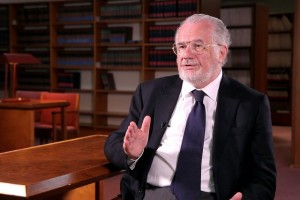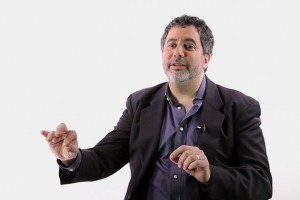Multiple Functions of Vitamin E
Tufts University professor, Angelo Azzi, on recent and historical discoveries surrounding vitamin E, problems ...
Photochemistry is the study of the interaction of light with molecules. It is of huge importance in the world because sunlight is the giver of life on this planet: all food ultimately comes from the action of sunlight on green plants, which turns carbon dioxide and water into carbohydrates, which is the ultimate food of all species. The fact that we can see is due to photochemical reactions which occur in the eye.
So, what we need to understand is how light interacts with molecules, so we need to think about the structure of molecules. Even simple molecules are joined together by the sharing or donating of electrons, which act in pairs. Quantum mechanics tells us that you cannot have two electrons in the same region of space unless they have another property which is different from the other and that property is electron spin. The electron spins on its axis, and so creates a magnetic field. You can’t have two electrons in the same physical region of space unless the magnetic field of one cancels out the magnetic field of the other. We call that a singlet state.
When the light of the correct energy comes along, you move one of those electrons from one region of space, one orbital as we call it, to another region of space, the different orbital, so now the constraints of what we call a Pauli exclusion principle no longer apply: there’s no reason for the two electrons to have opposing spins so they cancel out the magnetic fields. In the process of taking an electron from one orbital to another, there’s nothing that changes the spin, so the first thing that happens is you get what is called an excited electronic state. The electron has a huge amount of excess energy, which it needs to get rid of, but it still has the same spin arrangement as it had before; now, because the electrons are in different orbitals, you can change the spin of one of the electrons. So now, both electrons have the same spins, and the magnetic fields reinforce one another rather than cancel each other out. So, the molecule as a whole behaves like a small magnet, and we call that a triplet state in most molecules.
So, what are the fates of an excited singlet state to start with? It can drop back down to the state from which it started, the ground state, and it can give back out the light that it absorbed. But it always loses a little bit of energy, so the fluorescence is always at longer wavelengths than the light which is absorbed. That can be of great importance. That’s true in molecules; in atoms, you get the same radio in frequency, and you get the same wavelength of light in absorption as in emission. But in molecules, you lose energy.
The molecule can interact with other molecules and donate an electron or just donate its energy, so you have electron transfer processes and energy transfer processes. These can occur from both the singlet state and the triplet state, excited. The molecule can fall apart, it can fragment, you may have weakened one of the bonds, and so you get two fragments; or it can react with other molecules, which it collides with many different fates. Photochemistry really is the study of the rates of these processes, what happens in some molecules and a rationalization of why you get different behaviours: some molecules fluoresce extremely strongly, which is very useful in some dyestuffs, very useful in biology as fluorescent probes in microscopy, for example, whereas other molecules don’t fluoresce at all, they don’t seem to do anything, they just go back to the ground state and produce heat. So you have a very expensive Bunsen burner, if you like, in that case, it’s not very interesting. The triplet state is long-lived enough that it can interact with other molecules very, very readily.
So photochemistry is really the study of the fates of photoexcited molecules.
It was an empirical study through the 1930s, but the development of quantum theory really allowed us to make rationalizations about the rates of various processes. For example, the transfer of an electron from the ground state of a molecule to another orbital where you produce an excited state is subject to selection rules which are dictated by quantum mechanics; if a transition is fully allowed both spatially and due to the spin of the electron, then you have a very very powerful absorption process. Obviously, you would use something of that nature as a dye because you want to have maximum colour effects. you have a dye if the absorption is in the visible part of the spectrum, so you’re taking away some of the colours of the rainbow and leaving the others. The dyes usually have these very, very strong transitions.
To change the spin of an electron during that process of absorption is extremely difficult, so you have a factor of something like 100,000 less intensity in that absorption. It’s very hard to see it; you can if you use special circumstances. And there are all sorts of other kinds of minor restrictions: so the maximum you can have is a very powerful absorption in some dyestuffs, the minimum can be where you’re trying to change the spin of the electron, and that can be extremely weak.
The fate of the excited singlet state that you produce upon absorption really depends on those quantum mechanical rules as well. If the transition is easy, if it was easy to go up, it’s easy to come back down, and so those molecules you would expect to be extremely fluorescent, very strongly fluorescent, and we can make use of those properties.
If there is something in the molecule which enhances the spin change to form the triplet state, one of the electrons inverts its spin, then you’re left with a long-lived state: it won’t drop down to the ground state and give up light. It can, in some circumstances, be called phosphorescence. But usually, it hangs around and interacts with the environment, and one of the important interactions can be with simple molecules which are adjacent to the excited state. So an energy transfer process, for example, from the triplet state to molecular oxygen, which very unusually is itself a triplet state, although it’s in the lowest energy state, it’s a triplet as has unpaired electrons, and that produces then a singlet state of oxygen, you swap the energies, you swap one of the electrons, produce a singlet state which is higher in energy than the ground state oxygen, and that is an extraordinarily reactive species that will react with just about anything around it and cause damage, degradation. Polymers, for example, degrade readily under the action of sunlight through a mechanism associated with that.

We can make use of the singlet oxygen, which is produced in such a process and, indeed, in electron transfer processes, to do a whole variety of chemical things. But we can also do biological things with them. Plants, in fact, have a defence mechanism against producing singlet oxygen, which would destroy the chlorophyll which is used for driving the photosynthetic process. They have a triplet state scavenger which takes away the excited triplet state before it can interact with oxygen, so it preserves itself. But we can use this phenomenon to actually inflict damage on human tissue, and that leads us to a discussion on parameters which influenced that. We call that process photodynamic therapy.

Tufts University professor, Angelo Azzi, on recent and historical discoveries surrounding vitamin E, problems ...

Inspired by nature, researchers come up with a new way to transmute the most abundant gas in the atmosphere un...

Chemist Mark Tuckerman on classical nucleation theory, rare events phenomena, and energetic balance in the mel...